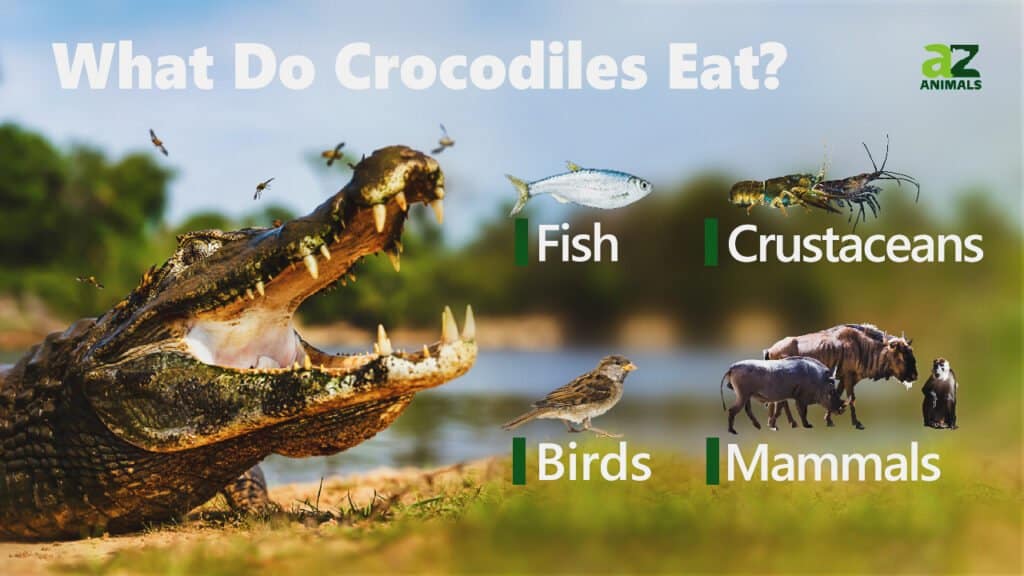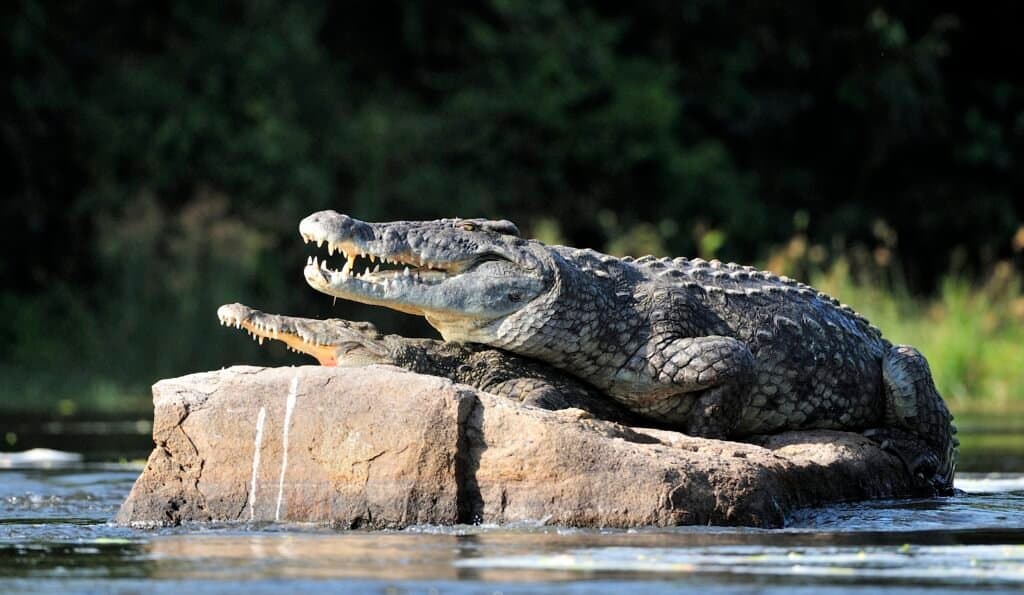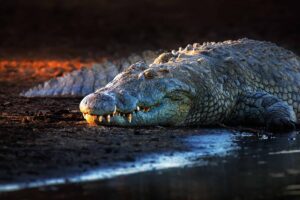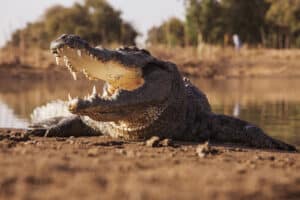Crocodiles are one of the longest-living creatures on Earth. It is believed ancient crocodiles inhabited Earth long before dinosaurs did! Today, they are considered one of the most powerful animals worldwide. Crocodiles are also one of the most fearful creatures, as they have been involved in many attacks on humans.
Despite that, like any other animals, they have their habits, preferences, and diet. They also have an interesting digestive system, which takes us to what they eat, how they digest their food, and how they excrete waste.
What if we told you that crocodiles ingest rocks to digest the prey they swallow? What if we told you that they do not poop and pee simultaneously, even though both are excreted through the cloaca? Yes, they are feared creatures, but, on the other hand, they have unique characteristics people know little about that make them curious animals. To help you better understand these reptiles, today we’ll talk about how they digest their food and how they poop!
What are crocodiles?

Crocodiles are primarily found in warm tropical waters.
©Martin Mecnarowski/Shutterstock.com
Crocodiles are large reptiles and apex predators. There are 18 crocodile species living throughout Africa, Asia, Australia, and North and South America. They are semi-aquatic animals inhabiting freshwater and saltwater habitats. Crocodiles are primarily found in warm tropical waters because they need sunlight to warm their bodies after they spend time in the water.
Crocodiles are highly adaptable and resilient creatures. They can be green, brown, gray, or black, which makes camouflage a piece of cake. They move through the water with the help of their vertically flattened tails. Moreover, crocodiles have a third eyelid, which means they can see underwater, as this lid protects the eyes from water damage.
Crocodiles can grow as large as 20 feet and weigh as much as 2,300 pounds – this applies to larger species, however! The smallest crocodile in the world, the dwarf crocodile is only 4.9 feet long and about 40 – 71 lbs. Paleontological evidence shows that the longest crocodile ever was the Sarcosuchus imperator. It reached 40 feet in length and weighed 17,600 pounds!
What do crocodiles eat, and what eats them?

Crocodiles are carnivorous animals. They are excellent predators that have developed incredible hunting techniques. Their diet depends on their age. Young crocodiles, for example, eat smaller animals, such as fish, small mammals, crustaceans, and birds. When they grow older and larger, they can feed on animals as big as deer or zebras.
Crocodiles have a very slow metabolism, so they’re fine with a meal once a week or even once a year, depending on how large the prey is. You read that right! Usually, adult crocodiles can have about 50 full meals in a single year if they want to keep in shape. However, these amazing reptiles can survive for up to two or even three years without eating at all!
Although they are apex predators, there were instances in which crocodiles were killed by lions, tigers, and jaguars. Small crocodiles can be prey to animals such as wild pigs and eagles. However, killing an adult crocodile is extremely difficult and is possible only if it’s in a disadvantageous situation.
How do crocodiles digest food?
Crocodiles swallow their prey whole. They do not chew it. So how do they digest it, considering that they can eat animals as big as deer, water buffalos, and even zebras? Let’s take a closer look at their digestive system.
The prey goes through the esophagus into their stomach. Here comes the most interesting part! A crocodile’s stomach is divided into two chambers. The first one may contain rocks that the crocodile has previously swallowed. This is where the food is ground, and the stones are there to help.
After the food is ground into smaller pieces, it goes into the second stomach chamber, which is more acidic. There, the food is digested. It then goes into the small intestine, which consists of the duodenum (the first part of the intestine), the jejunum (the middle part that connects the duodenum with the ileum), and the ileum (last part of the intestine).
From the small intestine, the food goes into the colon, which is considerably smaller than the small intestine. Only after this long “trip” do the excrements come out through the crocodile’s cloaca.
What do crocodile feces look like?

Crocodiles usually excrete feces in a single large dropping with varied colors, depending on their diet.
©Svetlana Foote/Shutterstock.com
Crocodile feces can be of different sizes depending on the animal’s size. Large individuals can leave waste as large as several inches.
Crocodiles usually excrete feces in a single large dropping with varied colors, depending on their diet.
Scientists collected feces from five different crocodile species:
- Slender-snouted crocodile;
- Morelet’s crocodile;
- Dwarf crocodile;
- Siamese crocodile;
- Philippines crocodile.
The results showed that the slender-snouted crocodile poop was the largest, reaching approximately 11 inches in length, while the Philippines crocodile excrement was the smallest. Moreover, most poops had a slight bending on one of their sides.
Do crocodiles poop and pee simultaneously?

Scientists believe crocodiles do not poop and pee simultaneously because their urine and feces aren’t collected in the same chamber.
©iStock.com/USO
Scientists believe crocodiles, just like ostriches, do not poop and pee simultaneously because their urine and feces aren’t collected in the same chamber, even though they are both excreted through the cloaca. These results were shown in a study based on Nile crocodiles.
The scientists determined that the crocodile cloaca consists of three chambers – the proctodeum, the urodeum, and the coprodeum. Results showed that the urodeum and the coprodeum serve as “urinary chambers” where urine is collected. They believe the urine gets there through two entrances located on the urodeum. The feces, however, accumulate in the rectum.
Based on these results, they affirmed that crocodiles might be able to pee and poop separately, just like ostriches, but this still requires further studies.
Incredible crocodile facts
- Crocodiles “cry” when they eat! They don’t literally cry, but their eyes produce tears when eating. This happens because the air in their sinuses gets into the tear duct, producing tears.
- Crocodiles often rest with their mouths wide open. This helps dissipate body heat.
- Baby crocodiles talk in their eggs! When they are ready to hatch, they produce sounds that help the “Croco” momma understand that the babies are ready to come out. The mother will then take the eggs from the sand and wait for the babies to hatch.
- Crocodiles are related to dinosaurs! Both crocodiles and dinosaurs descend from the Archosaurs group, which consists of birds, pterosaurs, crocodiles, and dinosaurs. Ancient crocodiles are believed to have inhabited Earth long before dinosaurs and were able to survive the extinction event that killed all dinosaur species!
The photo featured at the top of this post is © Rudi Hulshof/Shutterstock.com
Thank you for reading! Have some feedback for us? Contact the AZ Animals editorial team.






